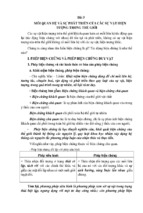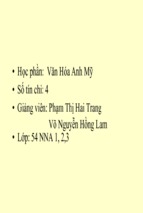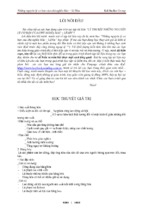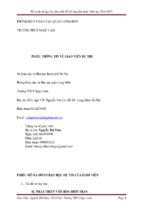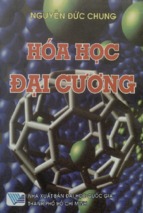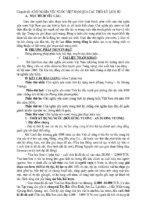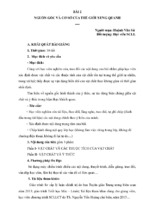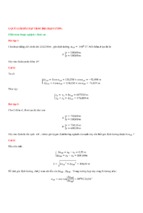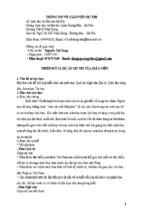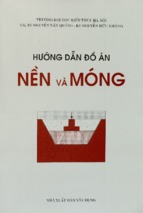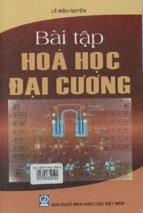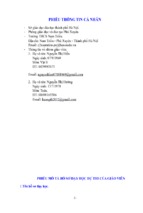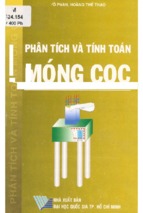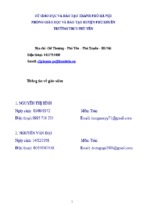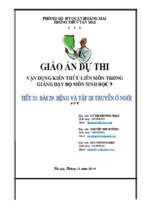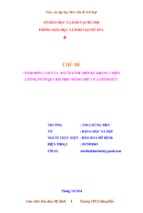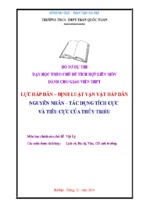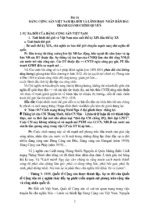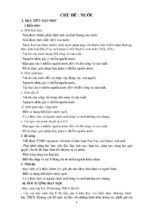Downloaded from ascelibrary.org by RMIT UNIVERSITY LIBRARY on 01/05/19. Copyright ASCE. For personal use only; all rights reserved.
Structures Congress 2017
Buildings and Special
Structures
Selected Papers from the
Structures Congress 2017
Denver, Colorado
April 6–8, 2017
Edited by
J. G. (Greg) Soules, P.E., S.E., P.Eng
Downloaded from ascelibrary.org by RMIT UNIVERSITY LIBRARY on 01/05/19. Copyright ASCE. For personal use only; all rights reserved.
Structures Congress 2017
Buildings and Special
Structures
SELECTED PAPERS FROM THE STRUCTURES CONGRESS 2017
April 6–8, 2017
Denver, Colorado
SPONSORED BY
The Structural Engineering Institute (SEI)
of the American Society of Civil Engineers
EDITED BY
J. G. (Greg) Soules, P.E., S.E., P.Eng
Published by the American Society of Civil Engineers
Downloaded from ascelibrary.org by RMIT UNIVERSITY LIBRARY on 01/05/19. Copyright ASCE. For personal use only; all rights reserved.
Published by American Society of Civil Engineers
1801 Alexander Bell Drive
Reston, Virginia, 20191-4382
www.asce.org/publications | ascelibrary.org
Any statements expressed in these materials are those of the individual authors and do not
necessarily represent the views of ASCE, which takes no responsibility for any statement
made herein. No reference made in this publication to any specific method, product, process,
or service constitutes or implies an endorsement, recommendation, or warranty thereof by
ASCE. The materials are for general information only and do not represent a standard of
ASCE, nor are they intended as a reference in purchase specifications, contracts, regulations,
statutes, or any other legal document. ASCE makes no representation or warranty of any
kind, whether express or implied, concerning the accuracy, completeness, suitability, or
utility of any information, apparatus, product, or process discussed in this publication, and
assumes no liability therefor. The information contained in these materials should not be used
without first securing competent advice with respect to its suitability for any general or
specific application. Anyone utilizing such information assumes all liability arising from such
use, including but not limited to infringement of any patent or patents.
ASCE and American Society of Civil Engineers—Registered in U.S. Patent and Trademark
Office.
Photocopies and permissions. Permission to photocopy or reproduce material from ASCE
publications can be requested by sending an e-mail to
[email protected] or by locating a
title in ASCE's Civil Engineering Database (http://cedb.asce.org) or ASCE Library
(http://ascelibrary.org) and using the “Permissions” link.
Errata: Errata, if any, can be found at https://doi.org/10.1061/9780784480410
Copyright © 2017 by the American Society of Civil Engineers.
All Rights Reserved.
ISBN 978-0-7844-8041-0 (PDF)
Manufactured in the United States of America.
Structures Congress 2017
iii
Preface
Downloaded from ascelibrary.org by RMIT UNIVERSITY LIBRARY on 01/05/19. Copyright ASCE. For personal use only; all rights reserved.
The Structures Congress has a robust technical program focusing on topics important to
Structural Engineers.
The papers in the proceeding are organized in 4 volumes
Volume 1 includes papers on Blast and Impact Loading and Response of Structures
Volume 2 includes papers on Bridges and Transportation Structures
Volume 3 includes papers on Buildings and Nonbuilding and Special Structures
Volume 4 includes papers on Other Structural Engineering Topics including; Business
and Professional Practice, Natural Disasters, Nonstructural Systems and Components,
Education, Research, and Forensics
Acknowledgments
Preparation for the Structures Congress required significant time and effort from the
members of the National Technical Program Committee, the Local Planning
Committee. Much of the success of the conference reflects the dedication and hard work
by these volunteers.
We would like to thank GEICO and Pearl for Sponsoring the Congress proceedings and
supporting the Structures Congress in such a generous way.
The Joint Program Committee would like to acknowledge the critical support of the
sponsors, exhibitors, presenters, and moderators who contributed to the success of the
conference through their participation.
On behalf of our dedicated volunteers and staff, we would like to thank you for
spending your valuable time attending the Structures Congress. It is our hope that you
and your colleagues will benefit greatly from the information provided, learn things you
can implement and make professional connections that last for years.
Sincerely,
J. Greg Soules, P.E., S.E., P.Eng, SECB, F.SEI, F.ASCE
© ASCE
Structures Congress 2017
iv
Contents
Downloaded from ascelibrary.org by RMIT UNIVERSITY LIBRARY on 01/05/19. Copyright ASCE. For personal use only; all rights reserved.
Buildings
Nonlinear Dynamic Analysis of Multi-Sloshing Mode Tuned Liquid
Sloshing Dampers Installed in Tall Buildings .......................................................... 1
U. Y. Jeong
Eliminating the Exposure Category from Wind Design Pressure ....................... 13
Nicole Ellison and Frederick R. Rutz
Wind Load Prediction on Tall Buildings in a Stochastic Framework ................. 24
M. Gibbons, J. Galsworthy, M. Chatten, and S. Kala
Experimental Investigation of Deconstructable Steel-Concrete Shear
Connections in Sustainable Composite Beams....................................................... 34
Lizhong Wang, Mark D. Webster, and Jerome F. Hajjar
Influence of Fastener Spacing on the Slip Modulus between Cold Formed
Steel and Wood Sheathing ....................................................................................... 48
Weston Loehr, Bill Zhang, Hani Melhem, and Kimberly Krammer
BRBM Frames: An Improved Approach to Seismic-Resistant Design Using
Buckling-Restrained Braces .................................................................................... 60
Leo Panian, Nick Bucci, and Steven Tipping
Implications of Modeling Assumptions on the Loss Estimation for Shear
Wall Buildings ........................................................................................................... 72
Kristijan Kolozvari, Vesna Terzic, and Daniel Saldana
Numerical Investigation of the Shear Buckling and Post-Buckling of
Thin Steel Plates with FRP Strengthening ............................................................. 87
Mohamad Alipour, Alireza Rahai, and Devin K. Harris
Seismic Evaluation of Incremental Seismic Retrofitting Techniques for
Typical Peruvian Schools ....................................................................................... 101
Gustavo Loa, Alejandro Muñoz, and Sandra Santa-Cruz
Advanced Technical Issues Related to Wind Loading on Tall Building
Structures in Consideration of Performance-Based Design ............................... 111
U. Y. Jeong and K. Tarrant
© ASCE
Structures Congress 2017
ASCE 41-17 Steel Column Modeling and Acceptance Criteria ......................... 121
Daniel Bech, Jonas Houston, and Bill Tremayne
Downloaded from ascelibrary.org by RMIT UNIVERSITY LIBRARY on 01/05/19. Copyright ASCE. For personal use only; all rights reserved.
Leveraging Cloud and Parametric Workflows to
Accelerate Performance Based Seismic Design ................................................... 136
Kermin Chok, Pavel Tomek, Trent Clifton, and Branden Dong
Stability of Steel Columns in Steel Concentrically Braced Frames
Subjected to Seismic Loading ................................................................................ 143
Guillaume Toutant, Yasaman Balazadeh Minouei, Ali Imanpour,
Sanda Koboevic, and Robert Tremblay
Classifying Cyclic Buckling Modes of Steel Wide-Flange Columns under
Cyclic Loading ........................................................................................................ 155
Gulen Ozkula, John Harris, and Chia-Ming Uang
Structural Behaviour of Demountable HSS Semi-Rigid Composite
Joints with Precast Concrete Slabs ....................................................................... 168
Abdolreza Ataei, Mark A. Bradford, and Hamid R. Valipour
Topology and Sizing Optimization of Nonlinear Viscous Dampers for the
Minimum-Cost Seismic Retrofitting of 3-D Frame Structures .......................... 179
Nicolò Pollini, Oren Lavan, and Oded Amir
Structural Topology Optimization Considering Complexity ............................. 192
Saranthip Koh, May Thu Nwe Nwe, Payam Bahrami, Fodil Fadli,
Cristopher D. Moen, and James K. Guest
Cast Steel Replaceable Modular Links for Eccentrically Braced Frames ........ 202
J. Binder, M. Gray, C. Christopoulos, and C. de Oliveira
New Methods in Efficient Post-Tensioned Slab Design Using Topology
Optimization ............................................................................................................ 213
M. Sarkisian, E. Long, A. Beghini, R. Garai, D. Shook, A. Diaz, and R. Henoch
Design and Parametric Finite Element Analysis—A Thin Lightweight
Two-Way Steel Flooring System ........................................................................... 225
Eugene Boadi-Danquah, Brian Robertson, and Matthew Fadden
Structural Form Finding of a Rope Sculpture ..................................................... 237
M. Sarkisian, E. Long, A. Beghini, and N. Wang
Discussion of Tubular Steel Monopole Base Connections:
The Base Weld Toe Crack Phenomenon;
Crack Identification and a Proposed Severity Classification System ................ 248
Brian R. Reese and David W. Hawkins
© ASCE
v
Structures Congress 2017
Design and Theory of Passive Eddy Current Dampers in
Building Structures ................................................................................................. 262
Mandy Chen and Lance Manuel
Downloaded from ascelibrary.org by RMIT UNIVERSITY LIBRARY on 01/05/19. Copyright ASCE. For personal use only; all rights reserved.
Effect of Damaged Fireproofing on the Behavior of Structural Steel
Members .................................................................................................................. 275
Ataollah Taghipour Anvari, Mustafa Mahamid, and Michael J. McNallan
A Re-Evaluation of f’m—Unit Strength Method, Face Shell, and Fully
Bedded Mortar Joints............................................................................................. 287
N. Westin and M. Mahamid
Parametric Study and Design Procedure for Skewed Extended Shear Tab
Connections ............................................................................................................. 301
Mutaz Al Hijaj and Mustafa Mahamid
Scaffolding a Landmark: The Restoration of the Dome of the United States
Capitol Building ...................................................................................................... 319
Christopher P. Pinto and Joelle K. Nelson
Achieving Column-Free Platforms—Design and Construction of Large
Span Station Mezzanines on the Second Avenue Subway Project ..................... 329
Renée Grigson and Michael Voorwinde
Evaluation of Full-Scale Adobe Brick Walls under Uniform Pressure ............. 343
S. Robert, H. El-Emam, A. Saucier, H. Salim, and Scott Bade
Experimental Study of Externally Flange Bonded CFRP for Retrofitting
Beam-Column Joints with High Concrete Compressive Strength ..................... 354
Olaniyi Arowojolu, Muhammad Kalimur Rahman, Baluch Muhammad Hussain,
and Ali-Al Gadhib
Considerations in the Use of Side Load Pier Brackets ........................................ 365
James Robert Harris and Kenneth Cobb
Retrofitting of Flange Notched Wood I-Joists with Glass Fiber Reinforced
Polymer (GFRP) Plates .......................................................................................... 375
M. Shahidul Islam and M. Shahria Alam
Multiple Hazards and Social Vulnerability for the Denver Region ................... 386
A. Rein Starrett and R. B. Corotis
A Top Down Approach to Achieve Full System Modeling in
Seismic Analysis and Design .................................................................................. 406
F. A. Charney
© ASCE
vi
Structures Congress 2017
Experimental and Numerical Investigation of Flexural Concrete Wall
Design Details .......................................................................................................... 418
A. Behrouzi, T. Welt, D. Lehman, L. Lowes, J. LaFave, and D. Kuchma
Downloaded from ascelibrary.org by RMIT UNIVERSITY LIBRARY on 01/05/19. Copyright ASCE. For personal use only; all rights reserved.
Seismic Response Study of Degraded Viscous Damping Systems for
Tall Buildings in China .......................................................................................... 434
H. Ataei, M. Mamaghani, and K. Kalbasi Anaraki
Topology Optimization and Performance-Based Design of Tall Buildings:
A Spatial Framework ............................................................................................. 447
Xihaier Luo, Arthriya Suksuwan, Seymour M. J. Spence, and Ahsan Kareem
Effects of Foundation Uplift on the Dynamic Response of Steel Frames .......... 459
Mohammad Salehi, Amir Hossein Jafarieh, and Mohammad Ali Ghannad
Performance-Based Wind and Seismic Engineering:
Benefits of Considering Multiple Hazards ........................................................... 473
Kevin Aswegan, Russell Larsen, Ron Klemencic, John Hooper,
and Jeremy Hasselbauer
Effect of Drift Loading History on the Collapse Capacity of Deep Steel
Columns ................................................................................................................... 485
T.-Y. Wu, S. El-Tawil, and J. McCormick
Properties of and Applications with Full Locked Coil Rope Assemblies .......... 495
K.-J. Thiem and M. Bechtold
U.S. Bank Stadium: Transparent Roof Steel Collaboration............................... 503
R. John Aniol, Rick Torborg, and Eric Fielder
Advanced Analysis of Steel-Frame Buildings for Full Story Fires .................... 515
Erica C. Fischer and Amit H. Varma
Integrated Fire-Structure Simulation Methodology for Predicting the
Behavior of Structures in Realistic Fires .............................................................. 527
Chao Zhang
Structural Design, Approval, and Monitoring of a UBC Tall Wood
Building .................................................................................................................... 541
T. Tannert and M. Moudgil
Adaptive Reuse of the Historical Ferdinand Building, Boston, MA .................. 548
John Looney
Fire Safety and Tall Timber Buildings—What’s Next? ...................................... 556
David Barber
© ASCE
vii
Structures Congress 2017
viii
The New Tocumen International Airport South Terminal in Panama City,
Panama .................................................................................................................... 570
Andrea Soligon, Jeng Neo, and Xiaonian Duan
Downloaded from ascelibrary.org by RMIT UNIVERSITY LIBRARY on 01/05/19. Copyright ASCE. For personal use only; all rights reserved.
Multi-Hazard Design of a New Emergency Communications Facility in
St. Louis, Missouri .................................................................................................. 582
Nathan C. Gould, Richard Hoehne, and Michael Shea
Prison Design in Haiti: Structural Challenges ..................................................... 592
David Dunkman, Christopher Hewitt, and Scott Hollingsworth
Underpinning Historic Structures at Grand Central Station, New York ......... 604
Yazdan Majdi and Richard Giffen
Design of an Underground Viaduct for the Expansion of the Moscone
Center....................................................................................................................... 614
A. Trgovcich, L. Panian, and S. Tipping
Nonbuilding and Special Structures
Extreme Wave Monitoring and In Situ Wave Pressure Measurement for
the Cofferdam Construction of the Pingtan Strait Bridge.................................. 629
Zilong Ti, Shunquan Qin, Yongle Li, Dapeng Mei, and Kai Wei
What We Learned from the Cooling Tower Foundation Design Challenges
from a Revamp Project .......................................................................................... 643
Silky Wong and Abhijeet Yesare
Design of Industrial Pipe Racks Using Modules, Pre-Assembled
Units, and Stick-Built Construction ...................................................................... 653
Xiapin Hua, Ron Mase, Khoi Ly, and Jkumar Gopalarathnam
Ship Impact and Nonlinear Dynamic Collapse Analysis of a Single Well
Observation Platform ............................................................................................. 668
Ahmed Khalil, Huda Helmy, Hatem Tageldin, and Hamed Salem
Pile Cap Seismic Load Transfer to Soil ................................................................ 681
Eric Wey, Rollins Brown, Candice Kou, and C. B. Crouse
Constructability Solutions for Temporarily Supporting 200’ Flare
Stacks during Construction Modifications ........................................................... 693
Mateusz Prusak, Nicholas Triandafilou, Mustafa Mahamid, and Tom Brindley
Custom Helical Pile Use for a Refinery Revamp: A Case Study ........................ 706
Eric Wey, Patrick Murray, Howard Perko, Malone Mondoy, and Paul Volpe
© ASCE
Structures Congress 2017
Structural Fatigue of Process Plant Modules during Ocean Transport ............ 721
Alan Shive and Marco Camacho
Innovative Use of FRP in Large-Diameter Piles for Vessel Impact ................... 735
M. A. McCarty, V. Zanjani, E. Grimnes, and J. Marquis
Downloaded from ascelibrary.org by RMIT UNIVERSITY LIBRARY on 01/05/19. Copyright ASCE. For personal use only; all rights reserved.
Seismic Analysis and Design for Wine Barrel Storage Racks ............................ 745
Tauras Stockus and Tzong-Ying Hao
Seismic Analysis and Design of a 21,000-Gallon Frac Tank Considering
the Fluid-Structure Interaction Effects for a FLEX Response at a
Nuclear Power Station ............................................................................................ 758
Christine H. Roy and Michael Mudlock
Seismic Behavior of Cylindrical Fluid-Filled Steel Tanks .................................. 772
Erica C. Fischer and Judy Liu
A Comparison of Approximate Methods for Period Determination in
Rack Structures ...................................................................................................... 782
Andrew Hardyniec, Charles DeVore, and Jeffrey Travis
© ASCE
ix
Structures Congress 2017
1
Nonlinear Dynamic Analysis of Multi-Sloshing Mode Tuned Liquid
Sloshing Dampers Installed in Tall Buildings
Downloaded from ascelibrary.org by RMIT UNIVERSITY LIBRARY on 01/05/19. Copyright ASCE. For personal use only; all rights reserved.
U. Y. Jeong1
1
Gradient Wind Engineering Inc., 127 Walgreen Rd., Ottawa, ON, Canada K0A 1L0.
E-mail:
[email protected]
Abstract
This paper presents nonlinear time domain analysis and its iterative formula
for a tuned-liquid sloshing damper installed on a tall slender building under strong
vortex shedding excitation. A new iterative formula is derived for a nonlinear time
domain analysis of a tuned liquid sloshing damper represented in the mathematical
model introduced by Warnitchai, P. in 1998. For the accurate modeling of liquid
(typically water) sloshing motion, the nonlinear quadratic damping force which is
generated by the liquid flow through a screen is directly implemented without
linearizing the term applied in previous studies (P. Warnitchai, 1998; M. J. Tait,
2008). Multi-sloshing modes of the liquid are also considered for more accurate
modeling. The nonlinear sloshing damper model has been analyzed coupled with tall
buildings with heights of 300m and slenderness ratios exceeding 10. The effects of
nonlinearity and multiple sloshing mode effects of the liquid and efficiency of the
sloshing dampers for different building frequencies and surrounding conditions are
investigated. Examples include (i) time and frequency domain analysis of, (ii) linear
and nonlinear, (iii) single- and multi- sloshing mode liquid dampers, (iv) coupled with
tall slender building with a range of building frequencies, (v) under strong vortex
shedding and generated from a target wind load spectra based on a Japanese Building
Code (AIJ). The present formula can be used to analyze and design liquid sloshing
dampers without physical damper test.
INTRODUCTION
Tall buildings often experience excessive building motions, which makes the
serviceability of buildings in terms of accelerations and torsional velocities exceed
the acceptable range according to the industrial guidelines (ISO, 1984; Isyumov, 1993,
1995). To mitigate the excessive motions, Tuned Liquid Sloshing Dampers (TLSDs)
have been frequently used due to their low cost, simple frequency tuning, and low
maintenance (Kareem, 1987, 1990; Fujino, 1995; Warnitchai, 1997; Tait, 2004, 2008;
Tait et al., 2004a, 2004b). The sloshing motion of the liquid in a tank can be
expressed as a combination of infinite sloshing modes based on potential flow theory
in consideration of wall and free surface boundary conditions (Baucer, 1984;
Warnitchai, 1997; Tait, 2004, 2008). In order to dissipate building’s vibration energy,
© ASCE
Structures Congress 2017
2
TLSDs are usually equipped with porous screens (Fediw et al., 1995; Warnitchai,
1997) immersed in the liquid. The damping force created by the porous screens are a
nonlinear function of water velocity flowing through the screens, which makes it
difficult to calculate the accurate damping force.
Downloaded from ascelibrary.org by RMIT UNIVERSITY LIBRARY on 01/05/19. Copyright ASCE. For personal use only; all rights reserved.
Previous studies consider the nonlinear screen damping force as approximate
linear form based on the assumption of the probabilistic distribution of the excitation
as sinusoidal or random signals (Caughey, 1963). However, since the wind-induced
excitation of the motion is not the same as the sinusoidal or random signals, for more
accurate modeling of the sloshing tank, nonlinear effects should be considered.
Kaneko and Ishikawa (1999) considered the nonlinear screen damping force in their
iterative solution of potential flow over the liquid domain based on Finite Difference
Method. Their method produces implicit solution of liquid sloshing motion requiring
discretization of liquid domain which makes the solution process a bit complicated
and time consuming.
In this paper, nonlinear formulas are derived to solve dynamic sloshing
motion of multi-sloshing mode a TLSD installed on a tall building in consideration of
the nonlinear screen damping force. To implement present method to the windinduced tall building vibration problem, the nonlinear TLSD model is coupled with
tall slender building immersed in strong winds. Here, for more accurate analysis of
wind-induced vibration of tall slender structure, aerodynamic damping and its timedomain formulas are also derived based on Rational Function Approximation (RFA)
(Fujino et al., 1995).
ACROSS-WIND BUILDING MOTION WITH AERODYNAMIC DAMPING
The dynamic equation of motion for a tall building under wind excitation can
be expressed as follows in modal domain in consideration of aerodynamic damping
~
force, f ae :
~
~ −1 ( ~
~
x + 2ξ s ωs ~
x + ω2s ~
x =m
f + f ae )
(1)
x , ~
x and ~
x represent the acceleration, velocity and displacement of the
where ~
generalized coordinate; and ξ s and ω s represent modal damping and natural angular
~ = modal mass; ~
f = modal wind load.
velocity respectively of the mode; m
Aerodynamic damping of tall buildings for across-wind excitation can be
measured from forced- or free-vibration response of a pivoting model in the wind
tunnel (Steckley, 1989; Watanabe et al, 1997; Katagiri et al., 2000). The aerodynamic
damping depends on building geometries, exposures, aspect ratios, side ratios and
amplitudes of vibration. The self-excited force in terms of aerodynamic damping and
© ASCE
Structures Congress 2017
3
stiffness can be expressed as follows in generalized coordinate by aerodynamic force
measurements obtained from forced vibration tests (Steckley, 1989):
~
~ηω2 (α + iβ) ~
f ae = −2m
x;
(2)
~) ; ω is angular velocity; α and β represent frequencywhere η = ρB H /(3m
dependent aerodynamic stiffness and damping respectively measured from the tests;
i = − 1 ; B= building width; H = building height.
Downloaded from ascelibrary.org by RMIT UNIVERSITY LIBRARY on 01/05/19. Copyright ASCE. For personal use only; all rights reserved.
2
BUILDING COUPLED WITH MULTI-SLOSHING MODE TLSD
Figures 1(a) to 1(d) show schematic diagrams of a building coupled with
simplified linear single-sloshing mode TLSD (Figure 1(a)) versus nonlinear multisloshing mode TLSD (Figure 1(c)), and their corresponding equivalent TMD (Tuned
Mass Damper) modeling in Figures 1(b) and 1(d) respectively. Here, it is noted that
~
the Figure 1(d) illustrates the aerodynamic forces, f ae , and the non-conservative
damping force, Qn .
For a damper with dimensions of b, h, and L corresponding to width, water
height and length, the equation of motion of the building-TLSD coupled system under
wind loading can be represented as follows based on equilibrium conditions of the
equivalent MTMD model in Figure 1(d):
~
ρwbhL ~ nd meq,n
~
~ −1 ( ~
x + 2ξ ω ~
+ ω2 ~
)
x
x
=
m
f
+
f
−
s s
s
ae
~ x − m
~ xr ,n
m
n=1
x
x + Χ x x + ω2 x = − ~
r ,n
eq , n
r,n
r ,n
eq , n r , n
(3)
(4)
In the above, ρw = liquid density; the second term in (4) corresponds to the nonconservative damping force, Qn , of sloshing mode n, illustrated in Figure 1(d); meq, n
is the effective mass of the nth sloshing mode defined below; xr , n , xr , n and xr , n
represent relative displacement between the motion of the equivalent mass and the
building (see Figure 1), and its first and second-order time derivatives respectively for
the nth liquid sloshing mode.
Furthermore, the noted parameters are defined as follows based on explicit solution of
Laplace equation defining the liquid in rectangular tank based on potential flow
theory (Warnitchai, 1997; Tait, 2008):
meq , n
© ASCE
nπh
2ρbL2 (1 − cos( nπ)) 2
tanh(
);
=
3
L
( nπ )
(5)
Structures Congress 2017
4
Χeq,n =
2(1 − cos(nπ))
nπh
tanh2 (
)Cl Δ nΞn ;
nπL
L
(6)
1
nπh
+ sinh − 2 (
);
3
L
ns
nπx j
);
Ξ n = sin3 (
L
j =1
Downloaded from ascelibrary.org by RMIT UNIVERSITY LIBRARY on 01/05/19. Copyright ASCE. For personal use only; all rights reserved.
Δn =
ωeq , n =
(7)
(8)
nπg
nπh
tanh(
).
L
L
(9)
In the above, x j indicate the location of the screen in the x-coordinate; ns denotes the
number of screen in the tank. The amplitude of sloshing height of nth sloshing mode,
qn , can be represented as follows using the modal participation ratio, Γn , and relative
displacement, xr , n :
qn = Γn xr , n .
Γn =
(10)
2(1 − cos(nπ))
nπh
tanh(
).
nπ
L
(11)
As shown in (4), the equation of the motion of the TLSD is a nonlinear
equation due to the velocity-dependent nonlinear liquid damping term, which is the
second term in the left side of the equation.
TIME DOMAIN FORMULA OF AERODYNAMIC DAMPING
Formulas for the tall building-TLSD coupled problem are derived in timedomain to directly calculate the peak factors and to take advantage of the other
benefits described before. Among the governing equations for the time-domain
analysis, the frequency-dependent aerodynamic damping and stiffness terms have to
be converted to terms solvable in the time-domain. The Rational Function
Approximation (RFA) method used originally in aeronautical engineering can be used
to represent the frequency-dependent aerodynamic damping and stiffness terms in
equation (2) and convert them to the following equations with constant coefficients
which can be solved in time-domain (Jeong, 2014):
U
U
U2
~ −1 ~
m
f ae = −2ηa3 ~
x − 2η H a2 ~
x − 2η H a1 ~
x − 2η H2
B
B
B
yj =
© ASCE
iωa j +3 ~ , for j=1 to m.
x
UH
iω+ dj
B
m
y
j
(12)
j =1
(13)
Structures Congress 2017
5
where a j for j=1 to m+3 represent rational function coefficients; d j are damping
terms for j=1 to m; m denotes number of rational function terms. The coefficients d j
should be selected to best fit the function.
Downloaded from ascelibrary.org by RMIT UNIVERSITY LIBRARY on 01/05/19. Copyright ASCE. For personal use only; all rights reserved.
TIME DOMAIN BUILDING – NONLINEAR MULTI-SLOSHING MODE
DAMPER COUPLED SYSTEM ANALYSIS
The governing equations for the nonlinear time-domain analysis building
motion coupled with TLSD under wind-excitation can be represented as follows by
combining the dynamic equation of motion for the building coupled with multisloshing mode TLSD in equations (3) and (4) as well as the auxiliary equations from
RFA in (12) and (13):
2
ρωbhL
~
x + (2ξ ω + 2η U H a ) ~
+ (ω2 + 2η U H a ) ~
+
2
η
a
)
x
3
2
1 x
s
s
s
~
m
B
B2
nd
meq,n
~
U2 m
+ ~ xr ,n + 2η H2 y j = m −1 f ;
m
B
(1 +
n=1
j =1
2
~
, for n=1 to ns;
x + xr ,n + Χ eq,n xr ,n x r ,n + ωeq
, n xr , n = 0
y j − a j +3 ~
x +
(14)
d jU H
B
y j = 0 , for j=1 to m.
(15)
(16)
In order to solve the coupled nonlinear dynamic equations in (14) to (16), Newmark
Beta step-by-step integration method is used after deriving incremental formula
including the nonlinear term in (15) for the iterative calculation. The solutions are
calculated until converged by the iterations for each time step.
EXAMPLE - ACROSS-WIND RESPONSE OF COUPLED TALL BUILDINGNONLINEAR MULTI-MODE TLSD
A tall building with building height, H, equals to 300 m, with plan dimension
B and D of 20 m by 20 m respectively is analyzed under mean hourly wind speed of
33.55 m/s defined at the top of the building height above the grade in open exposure
which corresponds to 10-year wind speed in Seattle, Washington. The exposure is
assumed to be open exposure with mean wind speed exponent, γ , of 0.14; turbulence
intensity at the building height corresponds to approximately 11 % and 10 % based on
3
ASCE (2010), ESDU respectively. The mass density of the building is 225 kg / m
and the mass is assumed to be distributed uniformly along the height of the building.
Structural damping ratio, ξ1 , equals to 0.15. The mode shape exponent μ is 1.5 which
is a typical value for tall buildings.
© ASCE
Structures Congress 2017
Downloaded from ascelibrary.org by RMIT UNIVERSITY LIBRARY on 01/05/19. Copyright ASCE. For personal use only; all rights reserved.
Across-wind load spectrum in AIJ (2006) has been used in this example due
to its simplicity and versatility covering different side ratios, although the applicable
aspect ratios of the building in AIJ are limited below 6. Figure 2 illustrates acrosswind spectrum used in the example. The peak value of the spectra due to the vortex
shedding occurs around 0.15 Hz which corresponds to the reduced frequency (=
f vs B / U H ) of 0.1, which is typical for the buildings with square plan ( Gu and Quan,
2004; Chen, 2014 ) where f vs = vortex shedding frequency. For time domain analysis,
a time history of the modal wind load has been generated from the target spectrum
based on Spectral Representation Method (Shinozuka and Jan, 1972; Deodatis, 1996).
According to Deodatis (1996), sample functions of multi-variate stochastic process
can be generated based on Cholesky decomposition of spectra matrix in combination
with random phasing. Figure 2 also illustrates a time series generated by the Spectral
Representation Method using the base moment spectrum. The figure shows an
excellent match between the spectrum of the generated time series versus the original
spectrum, which demonstrates the accuracy of the method.
Steckley’s (1989) motion-induced aerodynamic damping and stiffness under
pivoting excitation are used in the analysis. Since the amplitude-dependent nonlinear
characteristic of the aerodynamic damping (Chen, 2013, 2014) is not considered in
this study, the aerodynamic damping measured under small-amplitude is used. Figure
3 illustrates the coefficients of aerodynamic impedance ( α + iβ ) which represents
aerodynamic damping and stiffness of a building with a square-shaped building plan
with aspect ratio of 13.3 measured under nominal turbulence intensities of 17 %. As
shown in the figure, the aerodynamic damping in terms of β reduces as frequency
reduce and falls below zero which means negative aerodynamic damping where the
reduced frequency, K, is lower than 0.7. The figure also illustrates the fitted curves
for α and β using rational functions for the time-domain analysis.
Equations in (14) to (16) are analyzed both in frequency-domain and timedomain for the verification with building frequencies varying from 0.08 Hz to 0.3 Hz.
Since excessive building motions are expected due to the slenderness of the building,
TLSDs are optimally designed with various dimensions to be tuned to different
building frequencies, to provide 3% additional damping to the building. The effective
~ m /m
mass ratio of the damper (= meq / m
I ) is approximately 1.4 %; and the TLSD
1
is optimally tuned to the structural frequencies. The porous screens are also designed
to provide optimal damping to the damper based on random sloshing motion. The
TLSD-building system has been analysis using the equations (14) to (16) in
consideration of aerodynamic damping for 17% Turbulence Intensity.
Frequency-domain analysis and time domain analysis of the building-TLSD
coupled system is performed for the structural frequencies varying 0.08 to 0.3 Hz
using the generated wind load time series and the results are plotted in Figure 4. As
© ASCE
6
Structures Congress 2017
Downloaded from ascelibrary.org by RMIT UNIVERSITY LIBRARY on 01/05/19. Copyright ASCE. For personal use only; all rights reserved.
shown in the figure; around the region where the building frequency matches with the
vortex-shedding frequency of 0.15 Hz, the amplitude of vibration reaches its
maximum. The aerodynamic damping effects are favorable for the frequencies higher
than the vortex shedding frequency, therefore, the response reduced with AD,
whereas the amplitude has increased for the frequencies lower than the vortex
shedding frequency due to the unfavorable negative aerodynamic damping.
With optimally designed dampers installed on the building, the response
drastically reduces and the system becomes more stable even under the negative AD
at low building frequency. Linear Time-domain analysis results show excellent
agreements with those from the Frequency-domain analysis. However, due to the
system instability introduced by RFA, the result for 0.8Hz is deviated from that of the
Frequency-domain analysis. Nonlinear time-domain analysis results compared to
those from the linear analysis have increased for high frequency region, due to the
nonlinear damping force effect. However, the nonlinear analysis results fall very
close to the linear analysis results for low building frequencies.
Figure 5 shows a time history of the average liquid pressure on screens which
represents the non-conservatory damping force during the nonlinear time domain
analysis. The blue line represents the non-conservatory damping force per unit area (=
Qn / bh ), whereas the red line indicates directly calculated liquid pressure using
the liquid velocity and loss coefficient, Cl , of the screen. As shown in the figure, the
non-conservatory damping force is accurately calculated based on the present method.
Figure 6(a) and 6(b) illustrate liquid sloshing motions at two instantaneous
times during the nonlinear time-domain analysis of building with building frequency
of 1.0Hz. Whereas Figure 6(a) represents when the water sloshing height reaches its
maximum on the left wall in the figure and the motion is governed by the first antisymmetric sloshing mode, Figure 6(b) represents the moment when the water
sloshing motion is contributed by multiple modes which is considered in this study.
CONCLUSIONS
New formulas are derived for a nonlinear dynamic analysis of multi-sloshing
TLSD. In order to apply the method to wind design of tall buildings, required
formulas for motion-induced aerodynamic damping and stiffness are also derived
both in time- and frequency-domain. The TLSD is modeled as multiple equivalent
TMDs equipped with nonlinear damping force representing the non-conservatory
damping force created by the screen immersed in sloshing liquid.
Explicit solution for the sloshing motion of liquid in a rectangular tank is
derived in generalized coordinates representing liquid sloshing motion based on
potential flow theory. The non-conservatory nonlinear damping force are derived for
each mode for the time-domain analysis. A verification of present method is
© ASCE
7
Structures Congress 2017
attempted through an example of a typical tall slender building. From the analysis, the
nonlinear screen damping force effects are investigated which have increased
responses for the building with relatively high frequency.
Downloaded from ascelibrary.org by RMIT UNIVERSITY LIBRARY on 01/05/19. Copyright ASCE. For personal use only; all rights reserved.
The proposed time domain approach will enable more accurate evaluation of
wind response of tall buildings, more accurate design of TLSD reducing the
expensive dynamic damper testing, evaluating non-Gaussian processes such as real
peak factors, which will be very useful in tall building design.
REFERENCES
American Society of Civil Engineers (ASCE). (2010), Minimum design loads for
buildings and other structures, ASCE Standard ASCE/SEI 7-10.
Architectural Institute of Japan (AIJ). (2006), Recommendations for loads on
Buildings.
Baucer, H.F. (1984) “Oscillations of immiscible liquids in a rectangular container: a
new damper for excited structures,” J. Sound and Vibration, 93, 117-133.
Caughey, T.K. (1963) “Equivalent linearization techniques,” J. of Acoustical Society
of America, 35(11) 1706-1711.
Chen, X. (2013) “Estimation of stochastic crosswind response of wind-excited tall
buildings with nonlinear aerodynamic damping,” Engineering Structures, 56,
766-778.
Chen, X. (2014) “Extreme value distribution and peak factor of crosswind response of
flexible structures with nonlinear aeroelastic effect,”, J. Struct. Eng., ASCE,
online 0401491, 1-18.
Deodatis, G. (1996) “Simulation of ergodic multivariate stochastic processes,” J. of
Eng. Mech., ASCE, 122(8) 778-787.
Engineering Standard Data Unit (ESDU) Wind Engineering Sub-Series, ESDU
International Inc.
Fediw, A.A., Isyumov, N. and Vickery, B.J. (1995) “Performance of a tuned sloshing
water damper,” Journal of Wind Engineering and Industrial Aerodynamics, 57,
237-247.
Fujino, Y., Wilde, K., Masukawa, J. and Bhartia, B. (1995) “Rational function
approximation of aerodynamic forces on bridge deck and its application to
active control of flutter,” Proceedings of the 9th International Conference on
Wind Engineering, New Delhi, India.
Gu, M. and Quan, Y. (2004) “Across-wind loads on typical tall buildings,” J. of Wind
Eng. and Ind. Aerodyn. 92, 1147-1165.
International Standards Organization (ISO) 6897-1984: “Guidelines for the evaluation
of the response of occupants of fixed structures, especially buildings and offshore structures, to low frequency horizontal motion (0.063 to 1 Hertz).”
Isyumov, N. (1993) “Criteria for acceptable wind-induced motions of tall buildings,”
Proceedings of the International Conference on Tall Buildings, Council on Tall
Buildings and Urban Habitat, Rio de Janerio, Brazil.
© ASCE
8
Structures Congress 2017
Downloaded from ascelibrary.org by RMIT UNIVERSITY LIBRARY on 01/05/19. Copyright ASCE. For personal use only; all rights reserved.
Kaneko, S., Ishikawa, M. (1999) “Modeling of Tuned Liquid Damper with
Submerged Nets,” Transactions of ASME, 121, 334-343.
Kareem, A. and Sun, W.J. (1987) “Stochastic response of structures with fluidcontaining appendages,” J. of Sound and Vibration, 119(3).
Kareem, A. (1990) “Reduction of wind induced motion utilizing a tuned sloshing
damper,” J. of Wind Engineering and Industrial Aerodynamics, 36, 725-737.
Katagiri, J., Ohkuma, T., Marukawa, H. and Shimomura, S. (2000) “Motion-induced
wind forces acting on rectangular high-rise buildings with side ratio of 2,” J.
Struct. Constr. Eng., AIJ 534, 25-32.
Shinozuka, M. and Jan, C.-M. (1972) “Digital simulation of random processes and its
application,” J. of Sound and Vibration, 25(1), 111-128.
Steckly, A. (1989) Ph.D. Thesis, University of Western Ontario.
Tait, M.J., El Damatty A.A. and Isyumov, N. (2004) “Testing of tuned liquid damper
with screens and development of equivalent TMD model,” Wind and
Structures, An International Journal, 7, 215-234.
Tait, M.J., Isyumov, N. and El Damatty A.A., (2004) “The efficiency and robustness
of a uni-directional tuned liquid damper ad modeling with an equivalent TMD,”
Wind and Structures, An International Journal, 7, 235-250.
Tait, M.J. (2004) The performance of 1-D and 2-D tuned liquid dampers, Ph.D.
Thesis, University of Western Ontario.
Tait, M.J. (2008) “Modeling and preliminary design of a structure-TLD system,”
Engi. Struct., 30, 2644-2655.
Warnitchai, P. and Pinkaew, T. (1998) “Modeling of liquid sloshing in rectangular
tanks with flow-dampening devices,” Eng. Struct., 20(7), 593-600.
Watanabe, Y., Isyumov, N. and Davenport, A.G. (1997) “Empirical aerodynamic
damping function for tall buildings,” J. of Wind Eng. and Ind. Aerodynamics,
72, 313-321.
© ASCE
9
Structures Congress 2017
10
Porous
Screen
k1
TLSD
~
~
x
q
k1
~
f
fae
k eq
~
~
f
~
m
~
m
~
fae
c1
Downloaded from ascelibrary.org by RMIT UNIVERSITY LIBRARY on 01/05/19. Copyright ASCE. For personal use only; all rights reserved.
x
c1
(a) Single Sloshing Mode TLSD
~
x+x r
m eq
ceq
(b) Equivalnet Linear TMD Model
~
~
x
f
fae(ω)
keq,ns
~
Qns
TLSD
k1
k1
Q2
~
f
~
m
x+x r,ns
m eq,ns
~
keq,2
~
x
q
~
~
m
~
fae
c1
~
x+x r,1
k eq,1
c1
(c) Multi-Sloshing Mode TLSD
x+x r,2
m eq,2
Q1
m eq,1
(d) Equivalent N.L.-MTMD model
Figure 1. Schematic Diagram of Tuned Liquid Sloshing Damper (TLSD) Installed on
top of the Building
-1
10
-2
10
-3
fSM/(0.5 ρ UH2)2
10
-4
10
-5
10
-6
10
AIJ, 2006
Generated Wind Time History
-7
10
-8
10
-4
10
-3
10
-2
-1
10
10
0
10
1
10
f (Hz)
Figure 2. Comparison of Normalized Base Moment Spectra of Target Value based on
AIJ and Generated Time History
© ASCE

